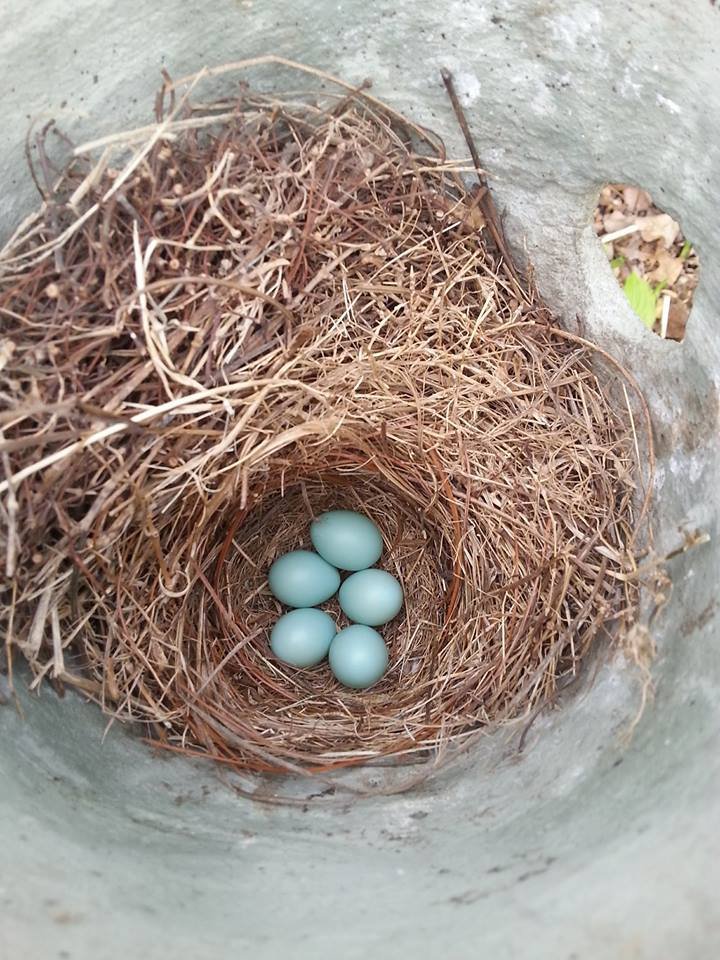In the coming weeks we will be sharing information about Bluebirds. We would like to address specific questions and concerns you may have that can then be shared with everyone. If you have questions regarding Bluebirds please email us at thewoodthrushshop@gmail.com and we’ll provide answers in our weekly blog, or directly back to you in an email.
Birds are beginning to sing and exhibit other courtship behaviors. The breeding season is fast approaching. Eastern Bluebirds have already begun searching and competing for mates and potential nest-sites. If you had planned on replacing an old nest box or moving one to a new location we suggest you do it now. And make it a point to clean out old nests now. Old nests will not prevent a Bluebird from building a new nest on top, however, the old nest debris is by now decaying and damp and can be a home to insects, like ants, which can be of great harm to hatched chicks.
Many of you in past weeks have seen multiple Bluebirds land on and look in nest boxes. (See video) In the video you will see classic courtship behaviors like wing fluttering. They may even carry some nest material to the box. This is not actual nesting but all part of courtship and choosing a nest site which the female will eventually approve.
Although most Bluebirds won’t begin their first nesting until early to mid-April, their search for nest sites will typically intensify in the last weeks of February and into March. Some eager Bluebirds may begin nesting as early as mid-March.
You may think you don’t have the right situation for Bluebirds because you’ve heard they have very specific needs for successful nesting. The most common fallacy we here from people is “I hear they need wide open spaces”. This is definitely not true. In fact, a lot of what you hear about the needs of Bluebirds is very much over stated. Bluebirds adapt very nicely to all kinds of situations including wooded yards. If Bluebirds needed the “perfect setup” as described by the many articles you find on the internet they would be extinct by now. These perfect nest-sites generally never existed in nature and have only been determined by humans.
In fact, before people started putting out nest-boxes for Bluebirds they nested in natural cavities including ones in trees. Bluebirds are considered a secondary cavity nester which means they will not excavate a nest, like a woodpecker does, but use one that has already been created. Once upon a time secondary cavities were in great supply but through habitat loss and competition Bluebirds were “forced” to adapt to birdhouses, or what we refer to as nest-boxes. Using nest-boxes is an example of Bluebirds’ adaptability. Offer a couple of nest-boxes in good locations and see what happens.
Here are a Few Tips to Choose a Location:
Position the nest box adjacent to the most open location available in your yard. Trees being around or close by are not a deterrent.
Bluebirds are typically more sensitive to nesting near a lot of bird traffic, so it’s not recommended nest boxes be placed near bird feeders. What’s a comfortable distance? It’s impossible to be exact but we would suggest about 100 feet away, or out of sight of feeding stations.
You may have heard that nest boxes need to face east. This is a good strategy to avoid prevailing weather patterns and rain but not at all necessary. My most successful box over the years faces northwest.
A Bluebird box does not need to be on a pole. The advantage of a pole is it allows you to position the box in the location you determine to be the best. Our pole system for Bluebird boxes will put the box at 5’ high after installation (convenient for monitoring and maintenance) and allows for a baffle if you’ve had a history of raccoon or rat snake predation. Bluebird boxes can be mounted on fences, and utility poles, and even outbuildings. The National Bluebird Society changed their opinion about tree mounting only a few years ago. Obviously a tree is a more vulnerable location when considering predators.
How many boxes can be offered in a typical yard situation? There is no harm in offering lots of nest boxes (birdhouses) in your yard but do not expect them to all get used at the same time especially if they are close in proximity to one another. In most cases backyard songbirds are too territorial to tolerate nesting close to one another, unless they are colony nesters like Purple Martins. But feel free to decorate your yard with lots of birdhouses if that’s your thing. Offering multiple nest-boxes is great and it does lessen the competition for a single box but do consider the nature of the species you are trying to attract and what kind of setting would be most appealing.
We are often asked “when is a good time to put up a bluebird box”? Every day is good. However, it is a great time to do so in the next few weeks. The sooner they know the box is there the more likely they will consider using it this season.
Get busy now and have fun with attracting Bluebirds this spring and summer.







